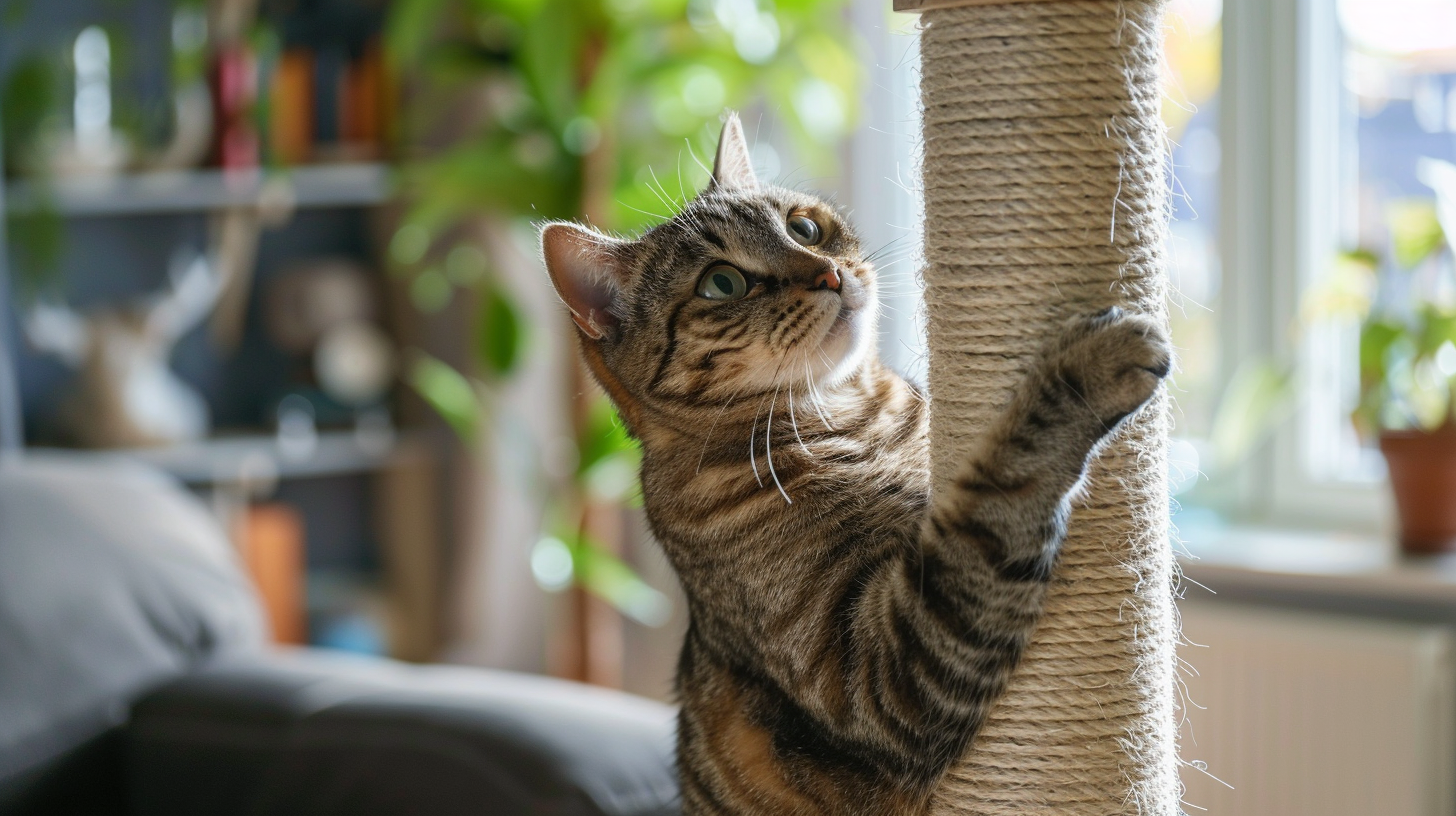Discover 6 effective, humane solutions for how to stop cat scratching furniture. Our expert guide provides proven techniques to protect your home while respecting your cat’s natural needs.
Table of Contents
Are you finding your beautiful furniture slowly transforming into frayed, shredded versions of their former selves? If your feline friend has turned your home into their personal scratching playground, you’re not alone. Cat scratching is one of the most common complaints among pet parents, but understanding how to stop cat scratching doesn’t have to be a mystery. This comprehensive guide will walk you through effective, humane solutions that respect your cat’s natural instincts while protecting your home.
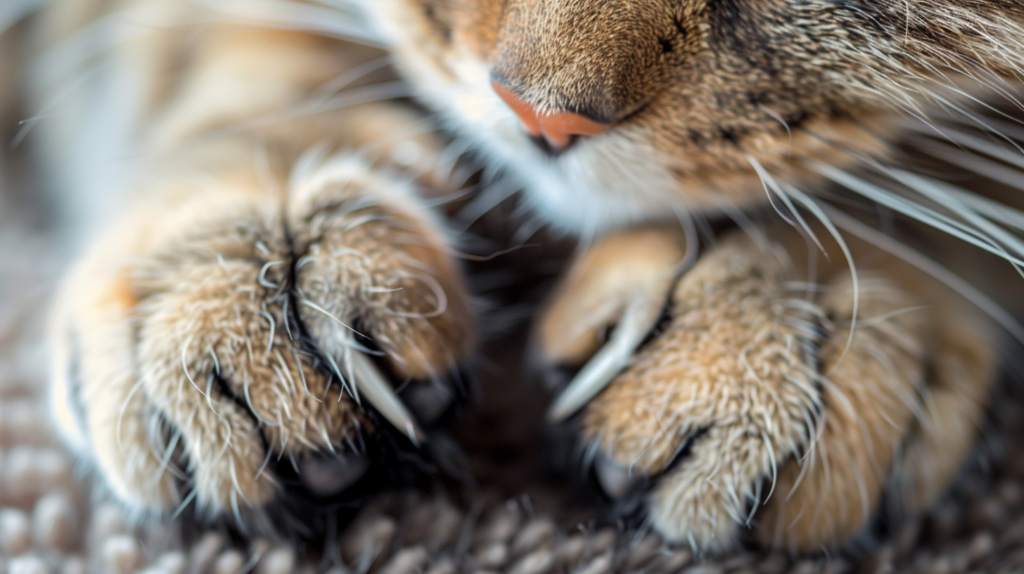
Understanding Why Cats Scratch
Before diving into solutions for how to stop cat scratching, it’s essential to understand why cats engage in this behavior in the first place. Scratching isn’t a sign of misbehavior or spite—it’s an innate, necessary feline behavior serving multiple important purposes.
Natural Instincts Behind Scratching
Cats scratch for several biological and psychological reasons:
- Claw Maintenance: Scratching helps cats remove the dead outer layer of their claws, keeping them sharp and healthy.
- Stretching Exercise: When cats scratch, they’re also stretching their bodies, particularly the muscles in their back, shoulders, and paws.
- Territory Marking: Cats have scent glands in their paw pads that release pheromones when they scratch. This marks their territory visually and with scent.
- Emotional Release: Scratching serves as a way for cats to relieve stress, excitement, or frustration—it’s a natural emotional outlet.
- Attention-Seeking: Sometimes cats learn that scratching furniture gets a big reaction from their humans, turning it into an attention-seeking behavior.
According to a study published in the Journal of Feline Medicine and Surgery, 95% of cats engage in scratching behavior regardless of whether they live indoors or outdoors. Dr. Elizabeth Bales, a veterinarian specializing in feline behavior, notes, “Scratching is as natural and necessary for cats as breathing. Our goal shouldn’t be to stop it completely but to redirect it appropriately.”
When Scratching Becomes Problematic
Normal scratching crosses into problematic territory when:
- Your furniture, carpets, or curtains are being damaged beyond repair
- Your cat is causing damage to rental property
- Family members are becoming frustrated or angry with the cat
- The behavior has suddenly increased in frequency or intensity (which can indicate stress or medical issues)
A survey by the American Pet Products Association found that destructive scratching ranks as the third most common reason cats are surrendered to shelters, highlighting the importance of addressing this issue effectively and compassionately.
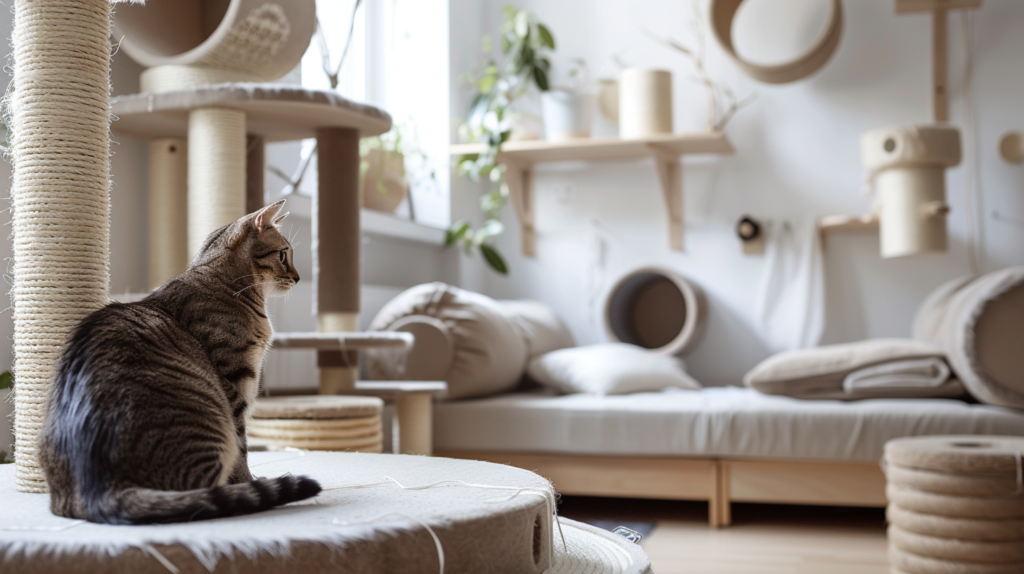
6 Effective Hacks for How to Stop Cat Scratching
Now that we understand why cats scratch, let’s explore six proven methods to redirect this natural behavior away from your furniture and toward appropriate surfaces.
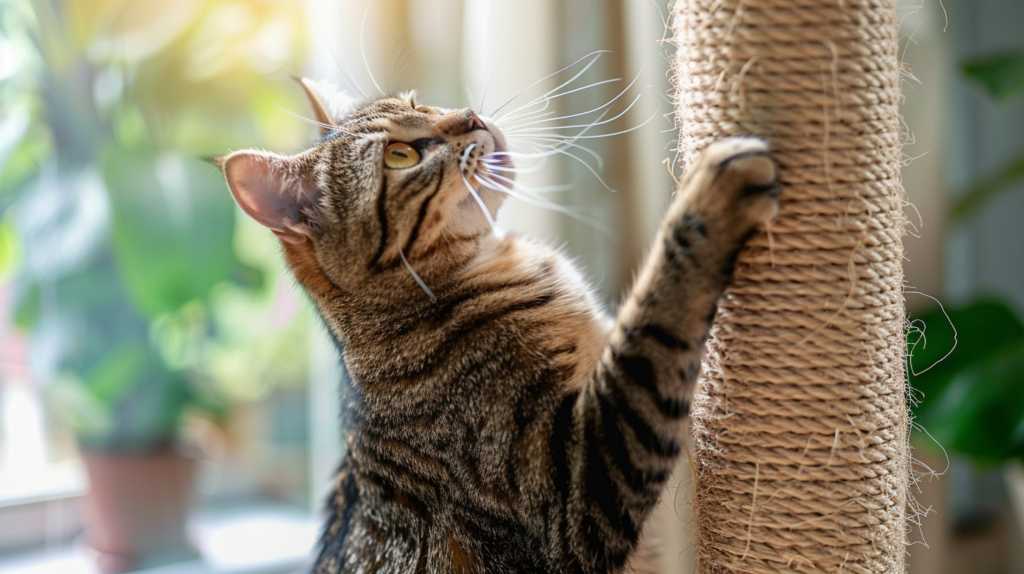
1. Provide Appropriate Scratching Alternatives
The foundation of any successful scratching management plan is providing your cat with appealing alternatives that satisfy their scratching needs.
Types of Scratching Posts and Surfaces
Cats have individual preferences for scratching surfaces and orientations:
Surface Material Preferences:
- Sisal Rope/Fabric: Many cats prefer the rough texture that offers good resistance
- Cardboard: Provides a satisfying tearing sensation
- Carpet: Some cats enjoy the plush texture
- Wood: Mimics natural tree bark that outdoor cats would naturally scratch
Orientation Preferences:
- Vertical Posts: Allows for a full-body stretch
- Horizontal Pads: Perfect for cats who like to scratch while lying down
- Inclined Surfaces: A middle ground that some cats prefer
A groundbreaking 2018 study in Applied Animal Behaviour Science found that 78% of cats preferred sisal fabric scratching posts over carpet-covered ones when given the choice, suggesting that texture plays a crucial role in scratching satisfaction.
Strategic Placement of Scratching Posts
Where you place scratching posts significantly impacts whether your cat will use them:
- Near Furniture Being Scratched: Place alternatives directly next to damaged furniture
- High-Traffic Areas: Cats often scratch in social, frequently visited areas
- Near Resting Areas: Many cats like to scratch after waking up from naps
- Multiple Locations: Provide scratching options in various rooms of your home
Dr. Marci Koski, a certified feline behavior consultant, recommends: “The rule of thumb is to have at least one scratching surface per cat, plus one extra, distributed throughout your home. This ensures that appropriate scratching options are always conveniently available.”
DIY Scratching Posts
Creating custom scratching posts can be both economical and allow you to tailor them to your cat’s preferences:
Simple DIY Sisal Post:
- Wrap a wooden post with sisal rope, securing with non-toxic glue
- Mount to a sturdy base
- Add a perch on top for added incentive
Cardboard Scratcher:
- Stack several layers of corrugated cardboard
- Cut into desired shape
- Secure with non-toxic glue
- Consider adding catnip to attract initial interest
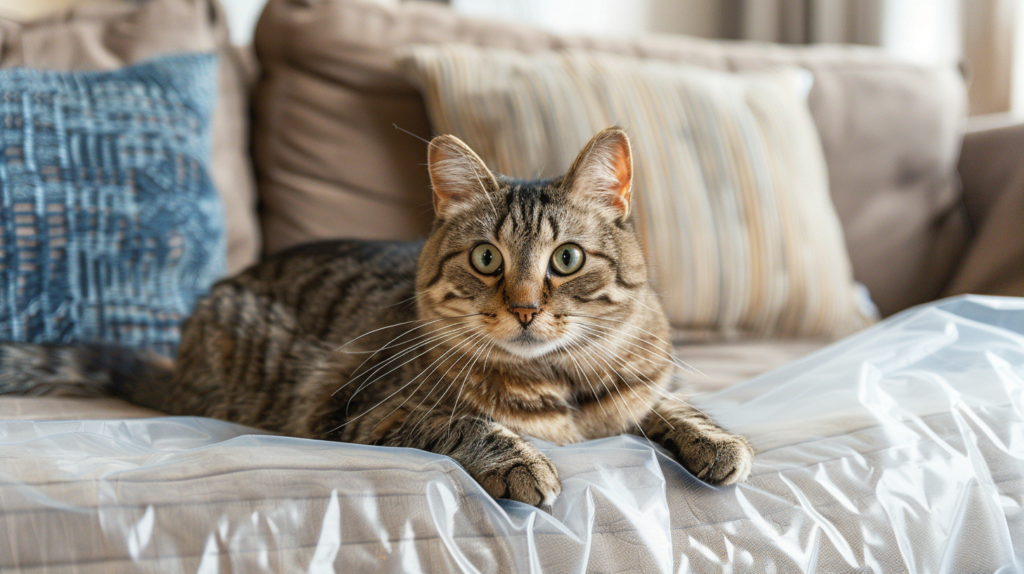
2. Use Deterrents Strategically
While providing alternatives is essential, you may also need to make inappropriate scratching surfaces less appealing to your cat.
Physical Deterrents
Several temporary physical barriers can protect furniture while your cat learns to use appropriate scratching surfaces:
- Double-Sided Tape: Products like Sticky Paws create an unpleasant tactile sensation that cats dislike
- Aluminum Foil: The texture and sound are unappealing to most cats
- Plastic Furniture Covers: Slippery surfaces that don’t provide the resistance cats seek
- Furniture Protectors: Clear vinyl corner guards can protect the most commonly targeted areas
A 2020 survey by the American Association of Feline Practitioners found that among physical deterrents, double-sided tape was reported as most effective, with 67% of cat owners noting a significant reduction in furniture scratching when applied consistently.
Scent Deterrents
Cats have sensitive noses and will avoid areas with certain scents:
- Commercial Deterrent Sprays: Look for products specifically designed for cats
- Citrus Scents: Most cats dislike the smell of orange, lemon, or grapefruit
- Herbal Deterrents: Rue, lavender, or rosemary may deter some cats
- Essential Oils: Use with extreme caution and in very diluted forms, as some can be toxic to cats
Important Safety Note: Always ensure any scent deterrents are cat-safe. Many essential oils are toxic to cats, including tea tree, peppermint, and eucalyptus. Consult with your veterinarian before using any scent-based deterrent.
Electronic Deterrents
Modern technology offers humane deterrent options:
- Motion-Activated Air Sprayers: Release a harmless burst of air when cats approach forbidden areas
- Ultrasonic Devices: Emit a high-pitched sound unpleasant to cats but inaudible to humans
- Vibration Pads: Create an unexpected vibration when touched
Dr. Nicholas Dodman, veterinary behaviorist and author of “The Cat Who Cried for Help,” cautions: “Electronic deterrents should never cause pain or fear. They should simply create a startling or unpleasant experience that the cat associates with the scratching location, not with you.”
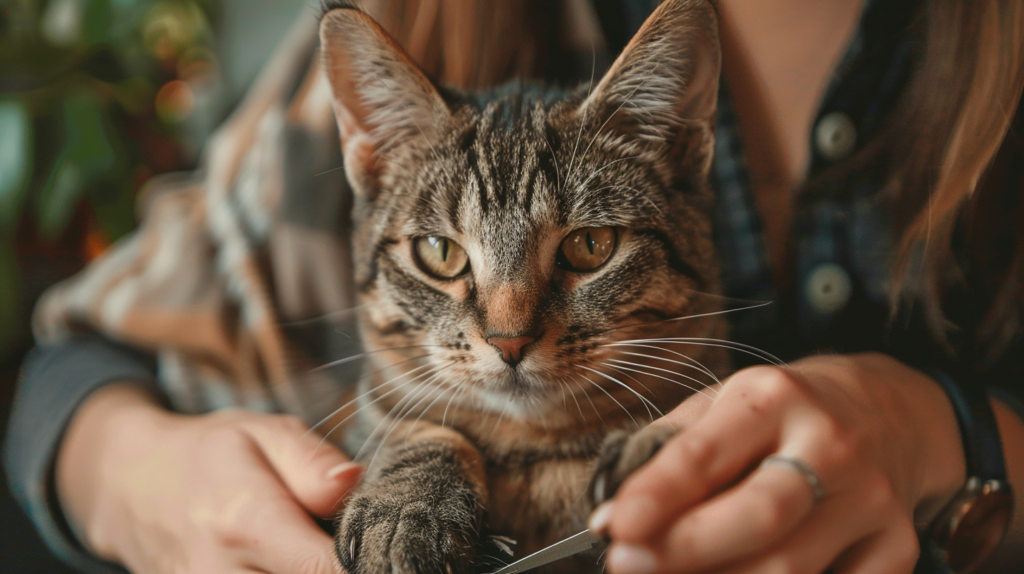
3. Regular Nail Maintenance
Keeping your cat’s claws trimmed won’t stop scratching behavior, but it can significantly reduce the damage caused when scratching does occur.
Proper Nail Trimming Techniques
Nail trimming requires patience and proper technique:
- Choose the Right Tools: Use sharp, cat-specific nail clippers or human fingernail clippers for smaller cats
- Create Positive Associations: Introduce clippers gradually with treats and praise
- Proper Positioning: Hold your cat comfortably in your lap or have a helper gently restrain them
- Identify the Quick: Look for the pink area within the nail and cut only the clear tip
- Trim a Small Amount: It’s better to trim less than risk cutting the quick
- Use Positive Reinforcement: Reward your cat with treats, praise, or play after trimming
For many cats, starting with just one or two nails per session can build tolerance over time. According to a study in the Journal of Veterinary Behavior, cats who received treats during nail trimming showed significantly less stress than those who didn’t, highlighting the importance of positive reinforcement.
Professional Grooming Options
If home nail trimming proves too challenging:
- Veterinary Technicians: Can quickly and safely trim nails for a modest fee
- Professional Groomers: Often include nail trimming as part of grooming packages
- Mobile Pet Services: Some areas have mobile groomers who come to your home
Nail Caps as a Temporary Solution
Vinyl nail caps (such as Soft Paws or Soft Claws) provide a humane alternative for persistent scratchers:
- How They Work: Clear or colored soft vinyl caps are glued to the cat’s claws
- Duration: Last approximately 4-6 weeks before naturally shedding with the outer nail layer
- Application: Can be done at home or by a veterinary professional
- Effectiveness: A 2019 survey of cat owners found that 83% reported significant reduction in furniture damage when using nail caps correctly
Dr. Sophia Yin, renowned veterinary behaviorist, noted that “nail caps can be an excellent temporary management tool while working on more permanent solutions like behavior modification and appropriate scratching post training.”
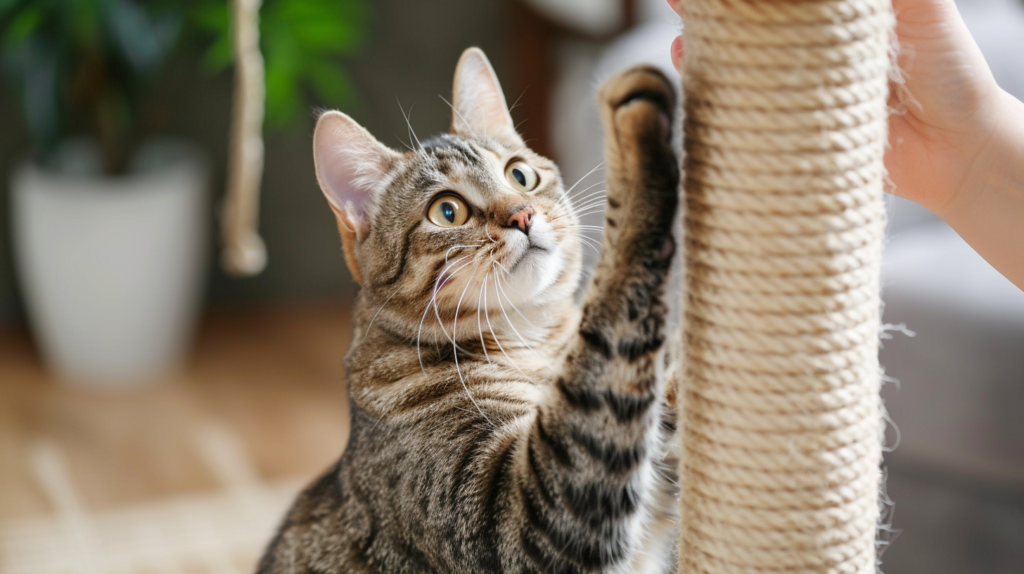
4. Behavior Modification Techniques
Training cats to redirect their scratching behavior requires consistency, patience, and positive reinforcement.
Positive Reinforcement Training
Encouraging appropriate scratching through rewards:
- Demonstrate the Post: Gently take your cat’s paws and mimic scratching motions on the post
- Reward Any Interest: Even sniffing or touching the post deserves praise initially
- Clicker Training: Associate the click with rewards, then click when your cat uses the post
- Catnip Incentive: Sprinkle or spray catnip on approved scratching surfaces
- Play Near Posts: Interactive play around scratching posts increases their appeal
A breakthrough study at the University of Lincoln found that cats trained with positive reinforcement techniques learned new behaviors three times faster than those without structured rewards, emphasizing the effectiveness of reward-based training.
Redirecting Unwanted Scratching
When you catch your cat in the act of scratching inappropriate items:
- Interrupt Gently: Use a neutral sound (like a clap) to distract, not scare
- Never Punish: Physical punishment damages your relationship and increases anxiety
- Immediate Redirection: Calmly move your cat to the appropriate scratching surface
- Reward Compliance: Praise and treat when they use the correct surface
- Consistency is Key: All family members must follow the same protocol
Certified Animal Behaviorist Jackson Galaxy recommends the “Yes/No” technique: “When you see inappropriate scratching, say ‘No’ neutrally, immediately redirect to an appropriate surface, and enthusiastically say ‘Yes!’ when they use it. This clear communication helps cats understand your expectations.”
Environmental Enrichment
Addressing the underlying needs that drive excessive scratching:
- Regular Play Sessions: At least 15-20 minutes of interactive play daily reduces excess energy
- Vertical Space: Cat trees, shelves, and perches satisfy territorial needs
- Window Access: Visual stimulation reduces boredom-related scratching
- Puzzle Feeders: Mental stimulation decreases stress-related behaviors
According to the Indoor Pet Initiative at Ohio State University, cats with enriched environments show 70% fewer problem behaviors, including destructive scratching, compared to cats in under-stimulated homes.
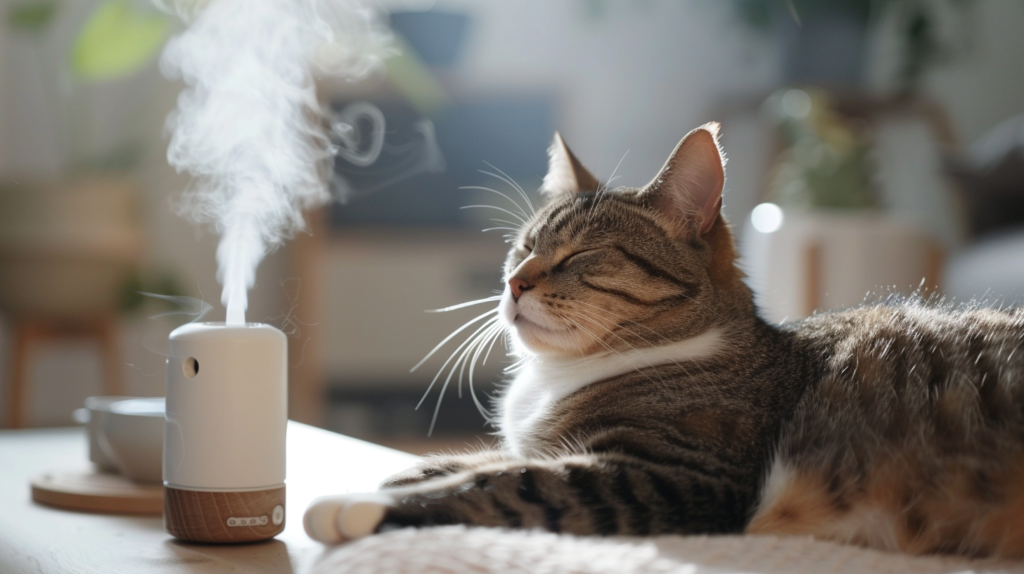
5. Consider Feline Pheromone Products
Synthetic pheromones can create a calming environment that reduces stress-related scratching.
How Pheromone Products Work
Feline facial pheromones are naturally produced by cats when they feel secure:
- Synthetic Replication: Products like Feliway mimic these natural pheromones
- Stress Reduction: Help create feelings of security and comfort
- Marking Reduction: May decrease territorial scratching behaviors
Application Methods
Pheromone products come in various forms:
- Diffusers: Plug-in devices that continuously release pheromones into a room
- Sprays: Can be applied directly to problem areas or scratching posts
- Wipes: For targeted application on specific surfaces
- Collars: Provide mobile pheromone release wherever your cat goes
A clinical trial published in the Journal of Feline Medicine and Surgery found that homes using feline facial pheromone diffusers saw a 95% reduction in marking behaviors, including inappropriate scratching, within two weeks of consistent use.
When to Consider Pheromones
Pheromone products are particularly helpful for:
- Stress-Triggered Scratching: During moves, renovations, or family changes
- Multi-Cat Households: Where territorial scratching may be more pronounced
- Anxiety-Prone Cats: Those with naturally nervous temperaments
- Complementary Approach: Works best alongside other management techniques
Veterinary behaviorist Dr. Karen Overall notes, “Pheromone products aren’t a miracle cure, but they can create an environment where behavioral modification techniques are more effective by reducing the underlying anxiety that often drives problem scratching.”
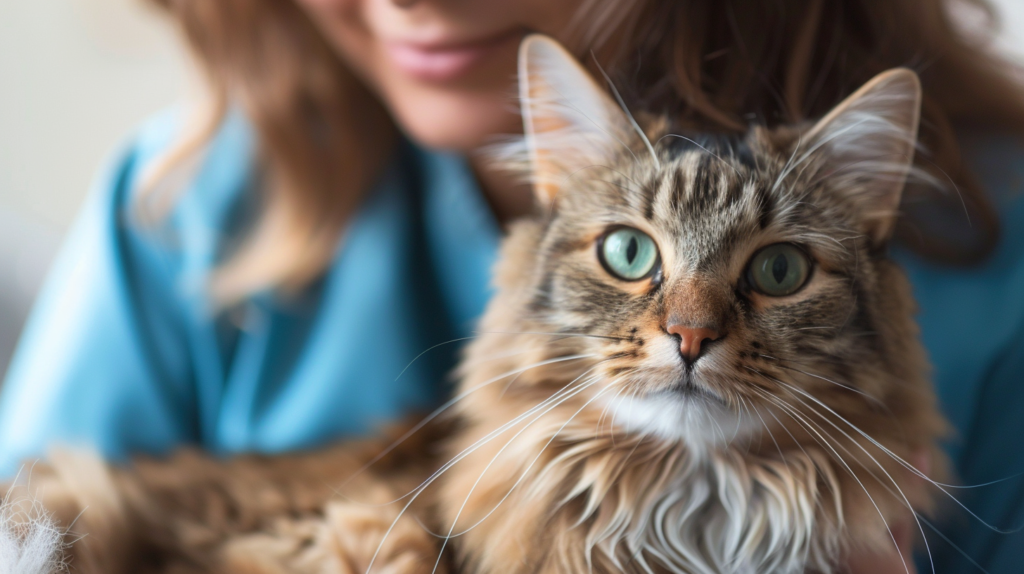
6. Consult with Veterinary Professionals
Sometimes, persistent scratching problems require professional intervention, especially if they represent a sudden change in behavior.
When to Seek Veterinary Help
Consider professional consultation if:
- Sudden Increase: Scratching behavior has dramatically intensified
- Obsessive Behavior: Your cat seems unable to stop scratching
- Self-Injury: Cat is causing wounds from excessive scratching
- Accompanying Symptoms: Changes in appetite, vocalization, or litter box habits
- Failed Interventions: Home remedies haven’t shown improvement after 4-6 weeks
Dr. Gary Landsberg, veterinary behaviorist and researcher, emphasizes: “Any sudden change in scratching behavior warrants a veterinary examination. Medical issues like skin allergies, parasites, or even arthritis can manifest as increased scratching and require specific medical treatment.”
Medical Considerations
Several medical conditions can influence scratching behavior:
- Skin Irritations: Allergies, parasites, or infections
- Pain Issues: Arthritis or injury causing compensatory behaviors
- Neurological Problems: Conditions affecting sensation or movement
- Thyroid Disorders: Can cause skin changes and behavioral shifts
- Stress-Related Dermatitis: Excessive grooming and scratching due to anxiety
Professional Behavior Consultation
For persistent behavioral scratching issues:
- Veterinary Behaviorists: Board-certified specialists in animal behavior
- Certified Applied Animal Behaviorists: Hold advanced degrees in animal behavior
- Certified Cat Behavior Consultants: Specifically trained in feline behavior issues
These professionals can develop customized behavior modification plans, identify environmental factors you may have missed, and in some cases, prescribe behavior-modifying medications when appropriate.
A 2021 study in the Journal of Veterinary Behavior found that 87% of cats with destructive scratching showed significant improvement after professional behavioral consultation and implementation of customized management plans.
A Note on Declawing
It’s important to address declawing, as it was historically considered a solution for scratching problems. However, the procedure is now recognized as harmful and unnecessary:
- What Declawing Actually Is: Surgical amputation of the last bone of each toe
- Physical Consequences: Chronic pain, arthritis, lameness, and behavioral issues
- Banned Practice: Prohibited in many countries and U.S. cities/states
- Professional Stance: Opposed by the American Association of Feline Practitioners, the American Veterinary Medical Association, and most animal welfare organizations
Dr. Jennifer Conrad, founder of The Paw Project, states: “Declawing doesn’t just remove claws; it amputates the last bone of each toe. This causes lifelong pain and alterations in how cats walk, balance, and behave. With so many humane alternatives available, there’s simply no justification for this procedure.”
The American Veterinary Medical Association’s position is that declawing “should be considered only after attempts have been made to prevent the cat from using its claws destructively or when its clawing presents a health risk for its owner(s).”
Putting It All Together: A Comprehensive Plan
Creating an effective strategy to address cat scratching requires a multi-faceted approach:
Step 1: Assessment
- Identify Problem Areas: Note all locations where unwanted scratching occurs
- Observe Timing: Track when scratching typically happens (morning, after play, etc.)
- Notice Preferences: Determine what textures and orientations your cat prefers
- Rule Out Medical Issues: Schedule a veterinary check-up if behavior is new or excessive
Step 2: Environment Modification
- Protect Furniture: Apply temporary deterrents to inappropriate scratching locations
- Strategic Post Placement: Position appropriate scratching surfaces near problem areas
- Multiple Options: Provide various types of scratching surfaces throughout your home
- Enrichment: Increase play, vertical space, and mental stimulation
Step 3: Training and Reinforcement
- Demonstrate Use: Show your cat how to use scratching posts
- Reward System: Establish consistent positive reinforcement for appropriate scratching
- Gentle Redirection: Move cat to proper surfaces when caught scratching furniture
- Nail Maintenance: Implement regular trimming schedule
Step 4: Monitoring and Adjustment
- Track Progress: Keep notes on behavior changes
- Eliminate Deterrents Gradually: Slowly remove temporary furniture protections as appropriate scratching increases
- Adjust Strategy: Be willing to try different scratching materials if initial choices aren’t successful
- Maintain Consistency: Continue reinforcement even after progress is made
According to a comprehensive study by the Animal Behavior Clinic at Tufts University, comprehensive management plans that address environment, behavior, and health aspects showed an 89% success rate in resolving problem scratching within three months.
Case Study: From Furniture Destroyer to Model Citizen
Sarah from Portland was at her wit’s end with her 3-year-old Maine Coon, Oscar, who had destroyed two sofas and countless chair legs with his persistent scratching. After consulting with a feline behavior specialist, she implemented the following plan:
- Medical Check: A veterinary exam ruled out any underlying health issues
- Strategic Post Placement: She placed three different scratching posts (sisal, cardboard, and wood) near Oscar’s favorite scratching spots
- Furniture Protection: She applied double-sided tape to sofa corners and used aluminum foil on chair legs
- Claw Maintenance: She scheduled bi-weekly nail trims with her veterinarian
- Enrichment: She added 20 minutes of daily interactive play and a cat tree by the window
- Positive Reinforcement: She used treats and praise whenever Oscar used appropriate scratching surfaces
Within three weeks, Oscar’s inappropriate scratching decreased by 70%. By eight weeks, he was consistently using his posts and had stopped damaging furniture entirely. Sarah noted, “The key was understanding that Oscar wasn’t being ‘bad’—he just needed appropriate outlets for his natural behavior.
Product Recommendations
Based on research and expert recommendations, these products have proven effective for many cat owners struggling with scratching issues:
| Product Type | Recommended Options | Key Benefits |
| Scratching Posts | SmartCat Ultimate Scratching Post PetFusion Ultimate Cat Scratcher Lounge | Tall, stable, sisal material Dual-purpose resting/scratching |
| Deterrents | SSSCAT Spray Deterrent Sticky Paws Furniture Strips | Motion-activated, humane Easy application, effective |
| Nail Care | Safari Professional Nail Trimmer Zen Clipper Pet Nail Clippers | Sharp blades, comfortable grip Guards against over-cutting |
| Nail Caps | Soft Claws Nail Caps PurrrfectPaw Soft Nail Caps | Durable, various sizes Easy application system |
| Pheromones | Feliway Classic Diffuser Comfort Zone Multi-Cat Diffuser | Clinically proven Formulated for multi-cat tension |
Frequently Asked Questions About How to Stop Cat Scratching
Q: Will my cat ever stop scratching completely?
A: No, scratching is a natural and necessary behavior for cats. The goal isn’t to eliminate scratching but to redirect it to appropriate surfaces. With proper training and environmental setup, cats can learn to scratch only on designated items rather than furniture.
Q: How many scratching posts do I need for one cat?
A: Experts recommend a minimum of two different scratching surfaces per cat, plus one extra. These should be placed in different areas of your home, particularly in social spaces where your cat spends a lot of time and near resting areas, as cats often scratch after waking up.
Q: My cat ignores the scratching post I bought. What should I do?
A: Cats have strong preferences for scratching materials and orientations. If your cat ignores a post, try different textures (sisal, cardboard, carpet) and orientations (vertical, horizontal, inclined). Place the post near where your cat currently scratches, use catnip or Feliway spray to attract them, and demonstrate scratching motions to show them how to use it.
Q: How do I train my kitten not to scratch furniture from the beginning?
A: Start early with appropriate scratching surfaces in prominent locations. When you bring your kitten home, immediately show them the scratching posts by gently placing their paws on the surface. Use toys to encourage play around the posts, and always praise scratching on appropriate surfaces. Consistently redirect any furniture scratching to the posts, and consider using Feliway Kitten to create a secure environment.
Q: Are there any breeds more prone to destructive scratching?
A: While all cats scratch, some breeds tend to be more energetic or have stronger scratching drives. Active breeds like Bengals, Abyssinians, and Oriental Shorthairs may require more environmental enrichment and scratching options. Larger breeds like Maine Coons and Norwegian Forest Cats often need sturdier, taller scratching posts due to their size and strength.
Q: How long does it typically take to redirect a cat’s scratching behavior?
A: With consistent training and appropriate environmental setup, most cats show significant improvement within 2-4 weeks. However, older cats with long-established scratching habits may take 2-3 months to fully transition to appropriate surfaces. Consistency, patience, and positive reinforcement are key to successful behavior modification.
For Expert Pet Care Tips and Product Recommendations
For more expert pet care tips and product recommendations, visit BlithePet.com — your trusted source for pet wellness. Our team of veterinarians and certified animal behaviorists regularly share the latest research and proven techniques for addressing common pet behavior challenges.
Conclusion: Creating Harmony Between Cats and Furniture
Understanding how to stop cat scratching furniture requires a balance of respecting your cat’s natural needs while protecting your home. By providing appropriate alternatives, using humane deterrents, maintaining regular nail care, implementing behavior modification techniques, and addressing any underlying medical or anxiety issues, you can successfully redirect your cat’s scratching behavior.
Remember that patience and consistency are essential. Cats respond best to gentle guidance and positive reinforcement rather than punishment or harsh deterrents. With time and the right approach, you can create a home where both you and your feline friend are comfortable and content.
Have a similar experience with your pet? Share it in the comments below!

